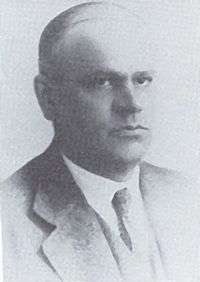Stanisław Ruziewicz
| Stanisław Ruziewicz | |
|---|---|
|
Stanisław Ruziewicz (c.a. 1939) | |
| Born |
29 August 1889 Podstaje |
| Died |
12 July 1941 (aged 51) Lviv, Nazi-occupied Poland |
| Nationality | Poland |
| Fields | Mathematics |
| Institutions | Jan Kazimierz University, Academy of Foreign Trade in Lwów |
| Alma mater | University of Lwów |
| Doctoral advisor | Wacław Sierpiński |
| Doctoral students | Stefan Kaczmarz |
| Known for | Ruziewicz problem |
Stanisław Ruziewicz (29 August 1889 – 12 July 1941) was a Polish mathematician and one of the founders of the Lwów School of Mathematics.
He was a former student of Wacław Sierpiński, earning his doctorate in 1913 from the University of Lwów; his thesis concerned continuous functions that are not differentiable.[1] He became a professor at the same university (then named Jan Kazimierz University) and rector of the Academy of Foreign Trade in Lwów. During the Second World War, Ruziewicz's home city of Lwów was annexed by the Ukrainian Soviet Socialist Republic, but then taken over by the General Government of German-occupied Poland in July 1941; Ruziewicz was arrested and murdered by the Gestapo on 12 July 1941 in Lviv, during the Massacre of Lviv professors.[2]
The Ruziewicz problem, asking whether the Lebesgue measure on the sphere may be characterized by certain of its properties, is named after Ruziewicz.[3]
References
- ↑ Stanisław Ruziewicz at the Mathematics Genealogy Project
- ↑ Wacław Sierpiński, as quoted in Rotkiewicz, A. (1972), "W. Sierpiński's works on the theory of numbers", Rendiconti del Circolo Matematico di Palermo, Serie II, 21: 5–24, doi:10.1007/BF02844227, MR 0323676: "In July 1941 one of my oldest students Stanislaw Ruziewicz was murdered. He was a retired full professor of Jan Kazimierz University in Lvov, the last rector of Foreign Trade Academy in Lvov, an outstanding mathematician and an excellent teacher."
- ↑ Lubotzky, Alexander (2010), "2 The Banach–Ruziewicz Problem", Discrete Groups, Expanding Graphs and Invariant Measures, Modern Birkhäuser Classics, Basel: Birkhäuser Verlag, pp. 7–18.
